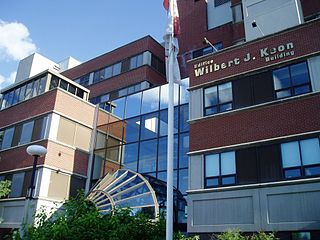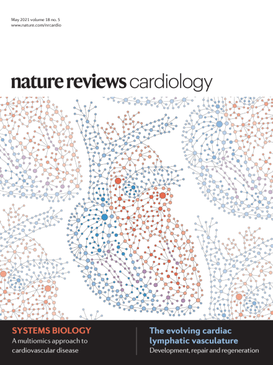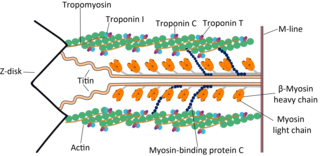
Cardiomyopathy is a group of primary diseases of the heart muscle. Early on there may be few or no symptoms. As the disease worsens, shortness of breath, feeling tired, and swelling of the legs may occur, due to the onset of heart failure. An irregular heart beat and fainting may occur. Those affected are at an increased risk of sudden cardiac death.
Hypertrophic cardiomyopathy is a condition in which muscle tissues of the heart become thickened without an obvious cause. The parts of the heart most commonly affected are the interventricular septum and the ventricles. This results in the heart being less able to pump blood effectively and also may cause electrical conduction problems. Specifically, within the bundle branches that conduct impulses through the interventricular septum and into the Purkinje fibers, as these are responsible for the depolarization of contractile cells of both ventricles.

The University of Ottawa Heart Institute (UOHI) (French: Institut de cardiologie de l'Université d'Ottawa ) is Canada's largest cardiovascular health centre. It is located in Ottawa, Ontario, Canada. It began as a department in The Ottawa Hospital, and since has evolved into Canada's only complete cardiac centre, encompassing prevention, diagnosis, treatment, rehabilitation, research, and education.

Dow Medical College is a public medical school located in the city of Karachi, Sindh, Pakistan. It was founded in 1945 and named after British civil servant Sir Hugh Dow, Governor of Sindh.

Nature Reviews Cardiology is a monthly peer-reviewed scientific journal published by Nature Portfolio. It was established in 2004 as Nature Clinical Practice Cardiovascular Medicine, but change name in April 2009. The editor-in-chief is Gregory Lim.

Cardiomegaly is a medical condition in which the heart becomes enlarged. It is more commonly referred to simply as "having an enlarged heart". It is usually the result of underlying conditions that make the heart work harder, such as obesity, heart valve disease, high blood pressure (hypertension), and coronary artery disease. Cardiomyopathy is also associated with cardiomegaly.
Ragavendra R. Baliga, FACC, FACP, FRCP (Edin) is a Professor of Medicine at The Ohio State University School of Medicine in Columbus, Ohio. He is a consulting editor of Heart Failure Clinics of North America, an indexed medical journal along with James B. Young, MD, Executive Dean, Lerner College of Medicine, Cleveland Clinic, Cleveland, Ohio. This is journal is known for editorials championing novel and esoteric mechanisms pertaining to cardiac function including ‘The Heart as the Concertina Pump’ and suggesting that stiffness of the great arteries contribute to cardiorenal syndrome. The most provocative editorial is a recent one that discusses the role of implantable cardiac defibrillators in sudden death. He is also Vice-Chief of the Division of Cardiovascular Medicine, at The Ohio State University of Medical Center.
Alcohol septal ablation (ASA) is a minimally invasive heart procedure to treat hypertrophic cardiomyopathy (HCM).

Cardiac muscle troponin T (cTnT) is a protein that in humans is encoded by the TNNT2 gene. Cardiac TnT is the tropomyosin-binding subunit of the troponin complex, which is located on the thin filament of striated muscles and regulates muscle contraction in response to alterations in intracellular calcium ion concentration.
The following outline is provided as an overview of and topical guide to cardiology, the branch of medicine dealing with disorders of the human heart. The field includes medical diagnosis and treatment of congenital heart defects, coronary artery disease, heart failure, valvular heart disease and electrophysiology. Physicians who specialize in cardiology are called cardiologists.

The myosin-binding protein C, cardiac-type is a protein that in humans is encoded by the MYBPC3 gene. This isoform is expressed exclusively in heart muscle during human and mouse development, and is distinct from those expressed in slow skeletal muscle (MYBPC1) and fast skeletal muscle (MYBPC2).
Robert Donald Teare, FRCP, FRCPath was a senior British pathologist.
Ulrich Sigwart is a German retired cardiologist known for his pioneering role in the conception and clinical use of stents to keep blood vessels open, and introducing a non-surgical intervention, alcohol septal ablation for the treatment of hypertrophic obstructive cardiomyopathy.
Srihari S. Naidu is an American physician and Professor of Medicine at New York Medical College who is known for his work on hypertrophic cardiomyopathy including the procedure known as alcohol septal ablation, and for helping to construct the universal diagnostic criteria for cardiogenic shock.
Professor Peter Sleight M.D.(Cantab.), D.M. (Oxon.) FRCP FACC was a distinguished and internationally renowned research cardiologist and an Honorary Consultant Physician at the John Radcliffe Hospital in Oxford and the Oxford University Hospitals NHS Foundation Trust. Sleight was Emeritus Field Marshal Alexander Professor of Cardiovascular Medicine at the University of Oxford and an Emeritus Fellow of Exeter College, Oxford.
Sir Richard Ian Samuel Bayliss was an English physician specialising in endocrinology. He became Physician to the Queen and head of the Medical Household.
James Scott FRCP, FIBiol, FMedSci, FRS is a British cardiologist.
Celia Mary Oakley MRCS FRCP FESC was a British cardiologist. She was one of the founding fellows of the European Society of Cardiology. Oakley was a recipient of the Laennec Master Clinician award and the Mackenzie medal.
William Paton Cleland FRCS FRCP FACS was an Australian born British cardiothoracic surgeon and was one of the early pioneers of open-heart surgery.

Charles Knight MD FRCP OBE is a British professor of cardiology and chief executive of St Bartholomew's Hospital, part of Barts Health NHS Trust.







